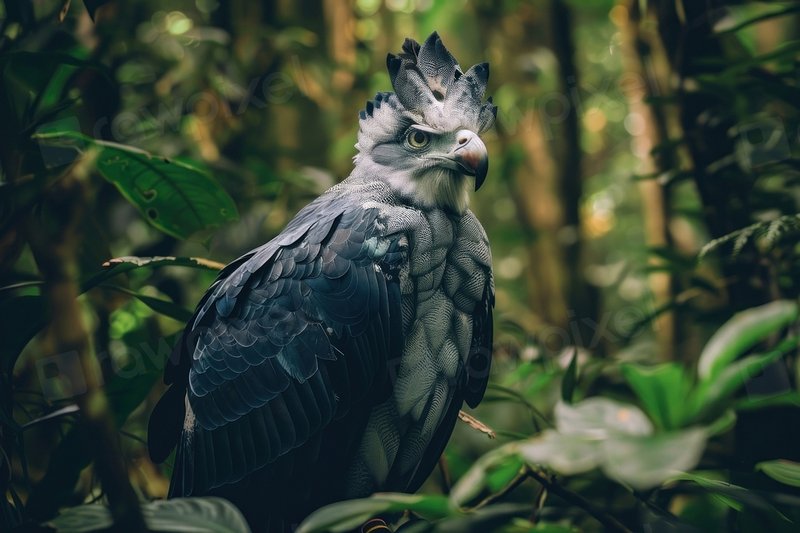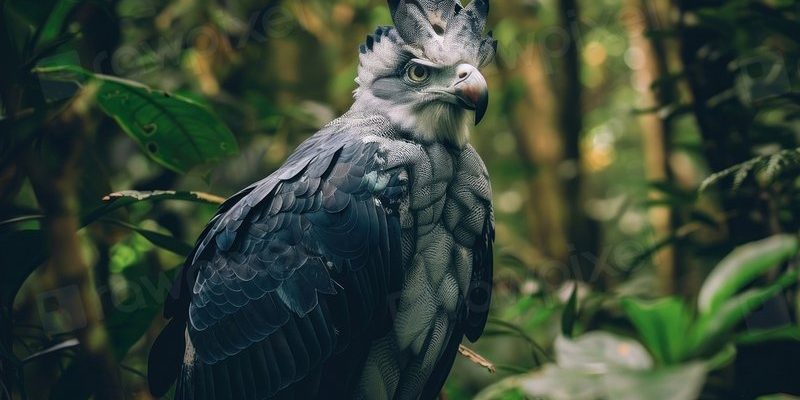
The Harpy Eagle is not just any bird; it’s a true icon of the rainforest. Imagine a creature that embodies raw power and stunning beauty—its broad wings and striking features make it one of the most magnificent eagles in the world. With a wingspan that can reach over six feet, the Harpy Eagle is often compared to the size of a human. When you see one soaring through the trees, it feels like nature has put on a show just for you.
These incredible birds are found in the dense canopies of Central and South America, where they reign as top predators. They primarily feast on medium-sized mammals, like sloths and monkeys. But what makes the Harpy Eagle even more fascinating is their unique hunting techniques and the strong bonds they form with their mates. Let’s dive deeper into this amazing species, exploring everything from their physical characteristics to their ecological importance.
Physical Characteristics
When you first catch a glimpse of a Harpy Eagle, it’s hard not to be in awe of their size and strength. Adult Harpy Eagles weigh between 6 to 10 kilograms (13 to 22 pounds), making them one of the heaviest eagle species. They stand about 70 to 107 centimeters (28 to 42 inches) tall, with females typically being larger than males. Their sharp, hooked beaks are designed for tearing flesh, while their powerful talons can exert a gripping force that rivals that of a lion’s bite.
Their plumage is equally impressive. The Harpy Eagle sports a striking combination of dark gray and white feathers, which help it blend into the shadows of the rainforest. The crest on their heads can stand upright, giving them a regal appearance. This feature is not just for looks; it can also help express their mood, much like a dog wagging its tail.
One of the most remarkable aspects of the Harpy Eagle’s anatomy is its eyes. With keen eyesight that allows them to spot prey from high above, they can detect movement from great distances. Imagine having eyesight so powerful that you could see a squirrel scurrying on the ground from a mile up in the air!
Habitat and Range
Harpy Eagles prefer to make their homes in tropical rainforests, which provide ample cover and abundant food sources. Their range spans from southern Mexico through Central America and into parts of South America, including countries like Brazil, Colombia, and Ecuador. Within these vast forests, they typically nest in tall trees, often choosing sites that are near a reliable food supply.
Their nests are quite large and can be used for many years, which speaks to the eagle’s commitment to their roost. They often choose trees that are at least 30 meters (98 feet) tall, as this height provides them with a strategic advantage for hunting while keeping their young safe from ground predators. If you ever wonder how they find these towering spots, just think about how a perfect lookout can turn into a real estate treasure for a bird of prey.
The Harpy Eagle’s habitat is increasingly threatened by deforestation and habitat destruction. As forests disappear, the chances for these magnificent eagles to find suitable nesting sites and food diminish. This is where conservation efforts become crucial. Protecting their rainforest home not only secures their future but also helps maintain the balance of the entire ecosystem.
Diet and Hunting Behavior
What does a Harpy Eagle eat? These birds are formidable hunters, primarily preying on sloths, monkeys, and various birds. Their hunting technique is fascinating. They are known for their ability to ambush their prey from a perch, utilizing the element of surprise to swoop down with lightning speed. Imagine a feathered ninja, stealthily waiting before launching into action!
Their diet is quite specialized, though. Harpy Eagles can often be found hunting in the same areas, as they develop a strong familiarity with the local wildlife. They typically hunt alone or in pairs and have a keen ability to spot movement in the dense foliage. Interestingly, their preference for larger prey allows them to capture only a few animals each week, making every hunt a significant event!
Once they catch their meal, the Harpy Eagle uses its powerful talons to grasp the struggling animal. That’s where their impressive grip comes into play. Their talons are about the size of a bear’s claws, allowing them to crush and carry their prey back to their nest. Imagine carrying a heavy backpack while climbing; that’s how it feels when a Harpy Eagle flies with a sloth as its dinner!
Reproduction and Lifespan
Harpy Eagles are monogamous, often forming lifelong pairs. When it comes to love, they are committed! Each breeding season, which usually occurs every two to three years, these eagles build or renovate their nests. The female typically lays one or two eggs, and both parents take turns incubating them, showcasing their teamwork.
After approximately 54 to 60 days, the eggs hatch, and the chicks emerge with fuzzy down feathers. The parents are devoted caregivers, feeding them regurgitated food for several months. As the young grow, they learn to spread their wings and eventually begin to grasp the essential skills needed for survival. This nurturing phase lasts a significant time; fledglings often take their first flights at around 4 to 5 months old.
In the wild, the lifespan of a Harpy Eagle can reach up to 25 years or more. However, various challenges arise, such as habitat destruction and hunting. Their longevity speaks to their resilience as a species, but it also highlights the need for conservation. Protecting these majestic birds ensures we can witness their beauty for generations to come.
Conservation Status
The Harpy Eagle is currently classified as Near Threatened by the International Union for Conservation of Nature (IUCN). This status primarily stems from habitat loss due to deforestation and hunting pressures. As rainforests are cleared for agriculture and urban development, the spaces these eagles thrive in become increasingly limited.
Conservation efforts are underway in many regions to protect their habitats. Organizations are working to create protected areas and restore ecosystems that have been damaged. Community awareness programs also aim to educate local populations about the Harpy Eagle’s importance. The more we understand about these birds, the better equipped we are to protect them.
Each of us can play a role in conservation, from supporting organizations dedicated to protecting wildlife to spreading awareness about the importance of biodiversity. The Harpy Eagle’s fate is intricately tied to the health of our rainforests. By supporting sustainable practices, we can ensure future generations enjoy these magnificent birds.
Interesting Facts About the Harpy Eagle
| Wingspan | Up to 2.2 meters (7.2 feet) |
| Weight | 6 to 10 kg (13 to 22 lbs) |
| Height | 70 to 107 cm (28 to 42 inches) |
| Diet | Sloths, monkeys, and birds |
| Life Span | Up to 25 years in the wild |
| Habitat | Tropical rainforests |
FAQ
What is a Harpy Eagle’s wingspan?
The wingspan of a Harpy Eagle can reach up to 2.2 meters (7.2 feet). This impressive size enables them to soar with grace through the dense canopy of the rainforest, giving them the ability to chase down prey with remarkable agility.
Are Harpy Eagles endangered?
Harpy Eagles are currently classified as Near Threatened by the IUCN. Their populations are at risk primarily due to habitat destruction, hunting, and environmental changes. It’s crucial to support conservation efforts to help protect them and their habitats.
What do baby Harpy Eagles eat?
Baby Harpy Eagles, or chicks, primarily feed on regurgitated food provided by their parents. Initially, this consists of small prey until they grow larger and can handle more substantial meals. As they mature, they start to learn hunting skills from their parents.
How do Harpy Eagles hunt?
Harpy Eagles hunt using a technique known as ambush hunting. They perch quietly in the treetops, patiently waiting for the right moment to swoop down and capture their prey. This stealthy approach is critical in the dense rainforest where visibility is limited.
How long do Harpy Eagles live?
In the wild, Harpy Eagles can live for up to 25 years. Their life span can be influenced by various factors, including habitat quality and availability of food sources. Vigilant conservation efforts are essential to ensure these magnificent birds have the chance to thrive for many years.
Where can I see Harpy Eagles in the wild?
Harpy Eagles can be found in tropical rainforests throughout Central and South America, notably in countries like Brazil, Colombia, and Ecuador. Visiting national parks and protected areas in these regions offers the best chance to see them in their natural habitats.
Do Harpy Eagles migrate?
Harpy Eagles are generally resident birds, meaning they do not migrate. They establish territories within their rainforest homes, which they defend throughout the year. This territorial behavior ensures they have enough resources to thrive.
What is special about a Harpy Eagle’s talons?
The talons of a Harpy Eagle are remarkably powerful, capable of exerting a grip strength comparable to that of a lion. This incredible force allows them to capture and carry large prey, such as sloths, back to their nests, making them formidable hunters of the rainforest.
How do Harpy Eagles communicate?
Harpy Eagles communicate through a variety of vocalizations, including whistles, chirps, and screeches. These sounds are often used to establish territory or to call to their mates. During breeding season, their vocalizations become more prominent as they engage in courtship displays.
What threats do Harpy Eagles face?
Harpy Eagles face several threats, including habitat destruction due to deforestation, hunting, and climate change. These challenges significantly impact their populations and require urgent conservation efforts to ensure their survival. Public awareness and protective measures are key to their continuation.
Can Harpy Eagles be kept as pets?
No, Harpy Eagles cannot be kept as pets. They are wild animals with specific needs that cannot be met in captivity. Additionally, it is illegal in many places to own wildlife as pets due to conservation regulations. Their place is in the wild, where they can thrive as nature intended.

